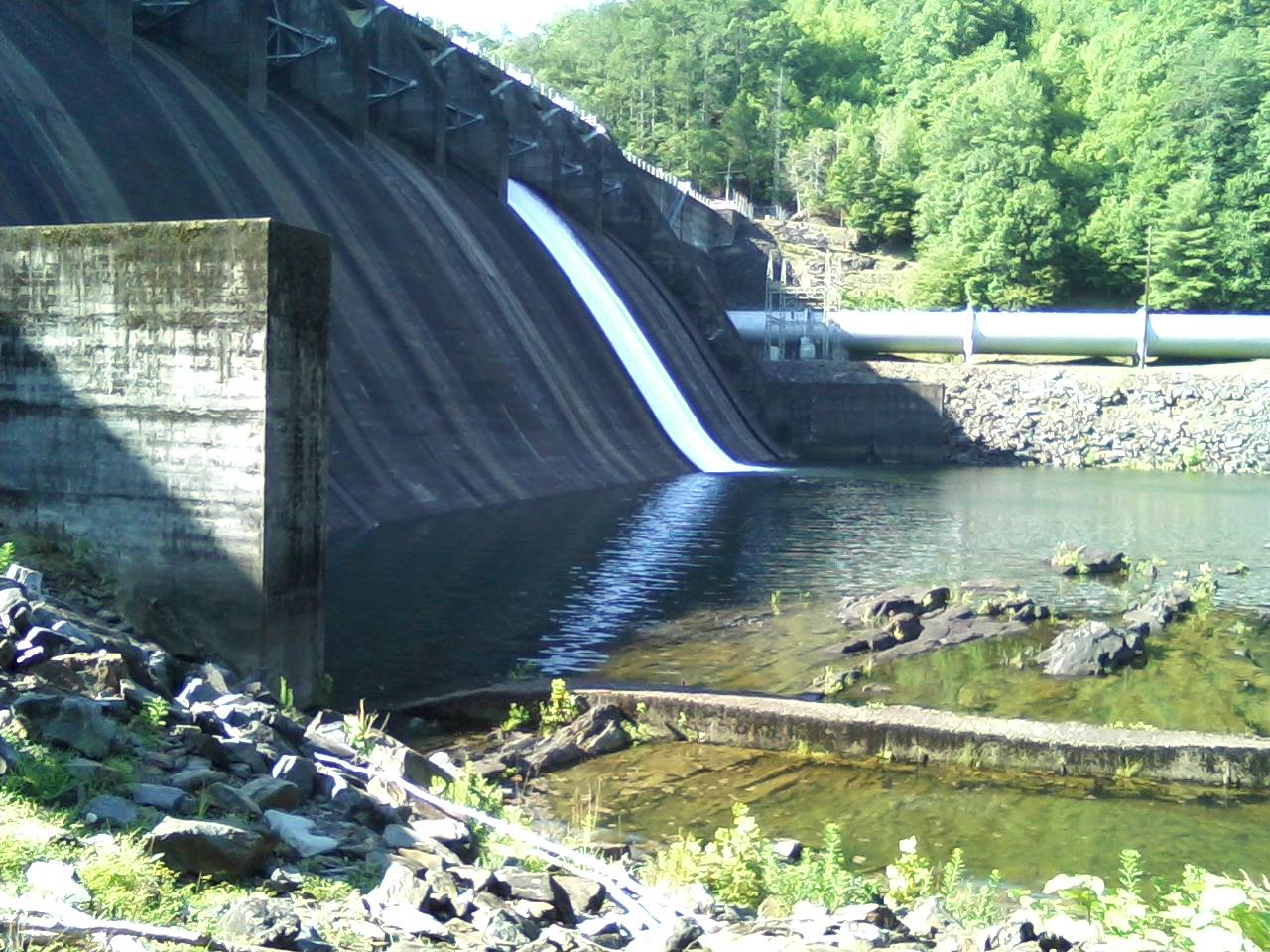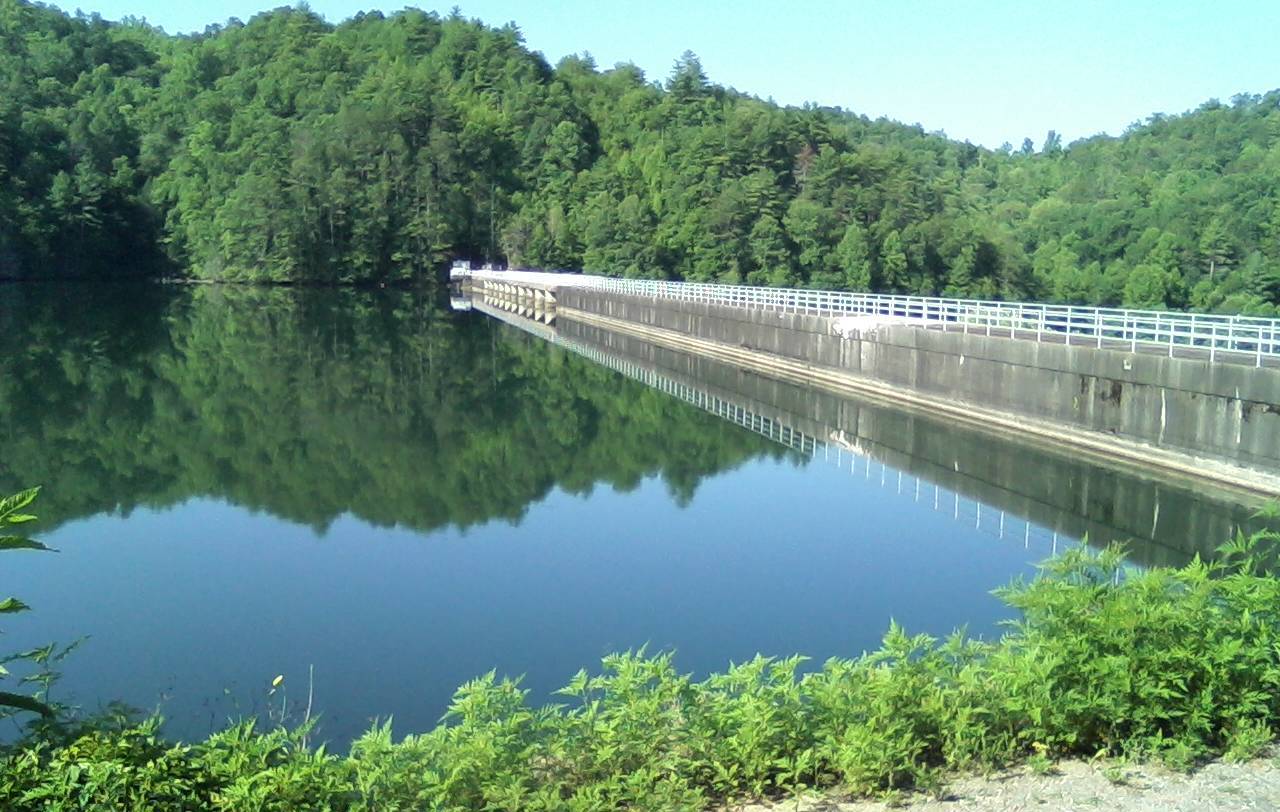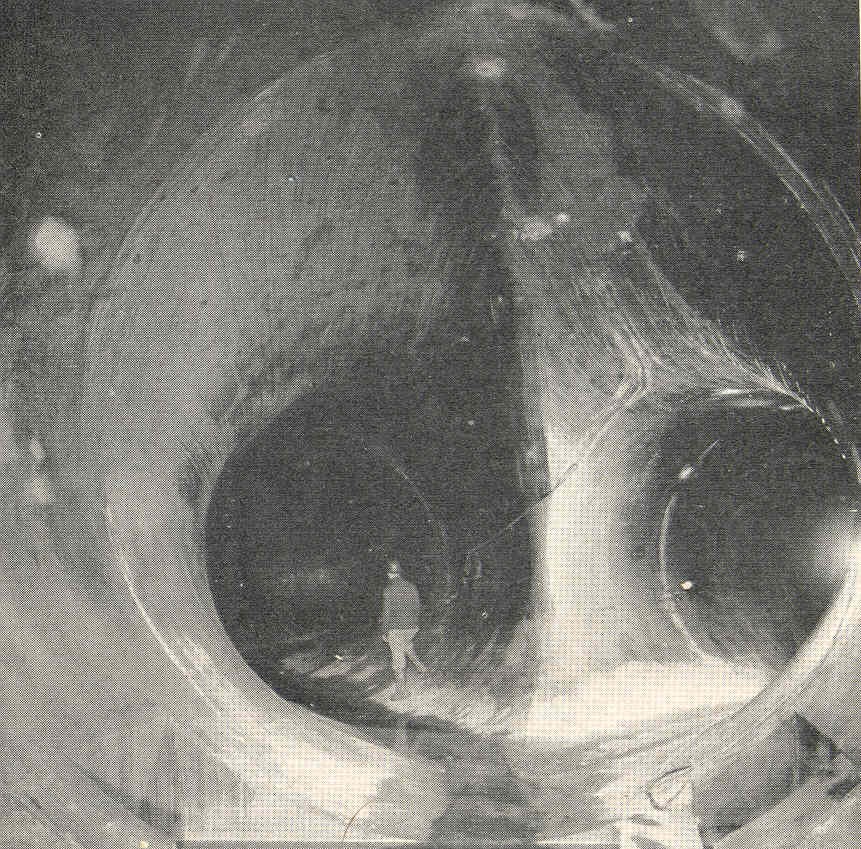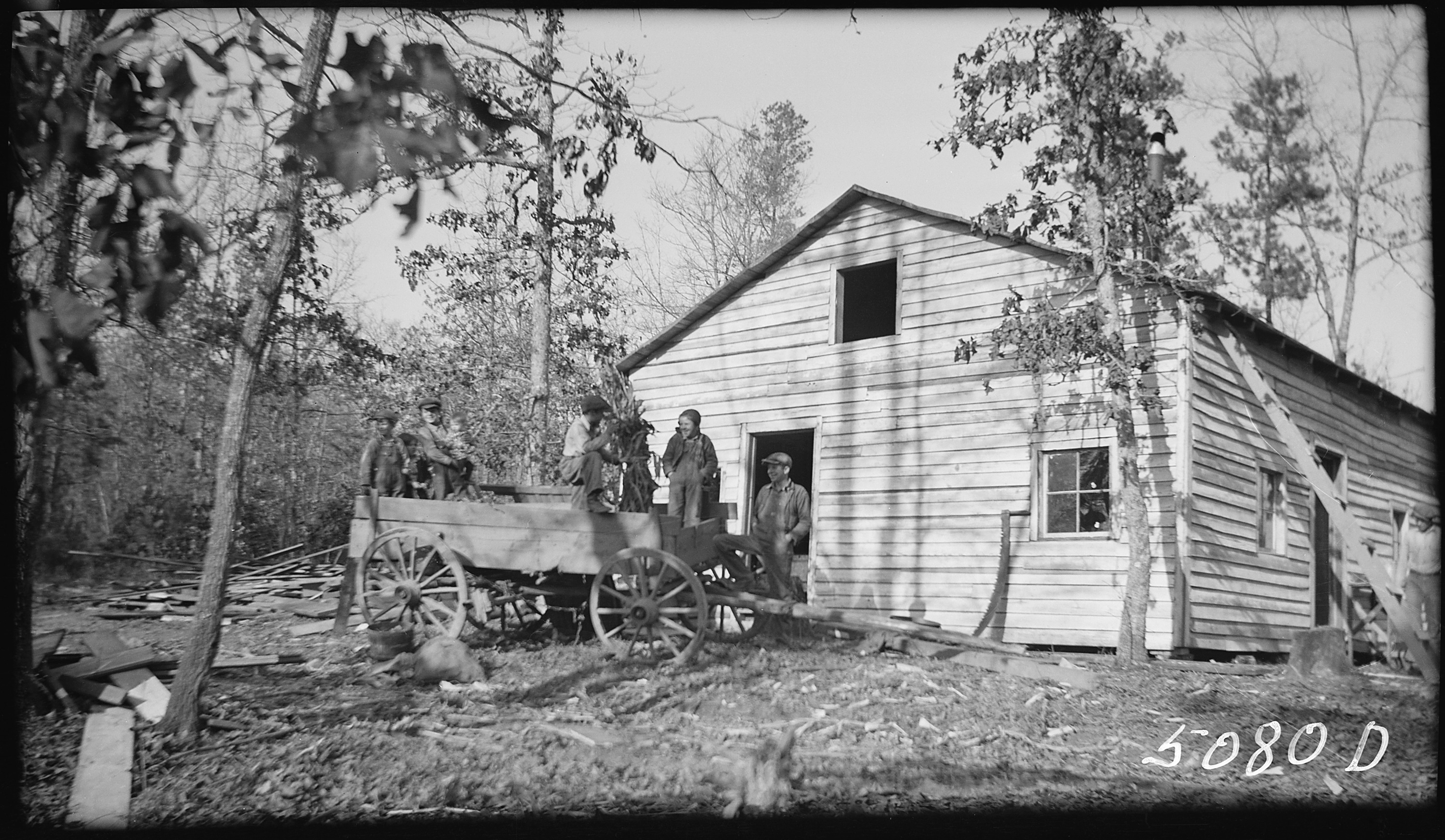Apalachia Hydroelectric Project on:
[Wikipedia]
[Google]
[Amazon]
Apalachia Dam is a

 Apalachia Dam's powerhouse is located downstream from the dam at the base of a steep-walled gorge formed as the river flows between two mountain formations. The dam's conduit— all but of which is underground— passes behind the cliffs on the south side of the river.
Apalachia Dam's powerhouse is located downstream from the dam at the base of a steep-walled gorge formed as the river flows between two mountain formations. The dam's conduit— all but of which is underground— passes behind the cliffs on the south side of the river.
Apalachia Reservoir
Retrieved: 26 January 2009. The dam's spillway is controlled by 10 radial gates with a combined discharge of .Tennessee Valley Authority, ''The Nickajack Project: A Report on the Planning, Design, Construction, Initial Operations, and Costs'', Technical Report No. 16 (Knoxville, Tenn.: Tennessee Valley Authority, 1972), pp. 10-11. Apalachia Lake stretches for to the base of Hiwassee Dam, and contains of shoreline and of water surface. A steel penstock connects the reservoir intake at the dam site to the conduit. The conduit emerges from a cliffside overlooking the dam's powerhouse, where it splits into two smaller tunnels which carry the water to a valve house. From the valve house, the water drops through two steel penstocks to the powerhouse turbines below. The total elevation drop from lake surface to power house discharge is to , depending on the lake level.
 Private and public entities had been aware of the hydroelectric potential of the Hiwassee River since the early 1900s. The U.S. Army Corps of Engineers identified several potential dams sites, including Apalachia, in the 1920s, and by the time the Tennessee Valley Authority was formed in 1933, several companies had bought up land and flowage rights in the Hiwassee Valley. TVA took the initiative in the valley, however, with the construction of Hiwassee Dam in the late 1930s. By 1941, the outbreak of World War II in Europe brought a drastic increase in the demand for electricity— especially to support aluminum production in the Tennessee Valley— and TVA quickly put together a plan to build several new dams, including Apalachia, all of which were authorized July 16, 1941. Work began on Apalachia the following day.
Private and public entities had been aware of the hydroelectric potential of the Hiwassee River since the early 1900s. The U.S. Army Corps of Engineers identified several potential dams sites, including Apalachia, in the 1920s, and by the time the Tennessee Valley Authority was formed in 1933, several companies had bought up land and flowage rights in the Hiwassee Valley. TVA took the initiative in the valley, however, with the construction of Hiwassee Dam in the late 1930s. By 1941, the outbreak of World War II in Europe brought a drastic increase in the demand for electricity— especially to support aluminum production in the Tennessee Valley— and TVA quickly put together a plan to build several new dams, including Apalachia, all of which were authorized July 16, 1941. Work began on Apalachia the following day.
 The construction of Apalachia Dam and its reservoir required the purchase of of land, most of which was in possession of three private entities— the Union Power Company, the Hiwassee-Nolichucky Power Company, and the Hiwassee River Power Company, with Union holding nearly half of the . After the initial purchase, the Hiwassee-Nolichucky Power Company sold TVA an additional , nearly tripling the reservation size. Land for the conduit was transferred by the U.S. Forest Service. Since most of the land was in possession of private companies, only 22 families and of roads had to be relocated.
The construction of the conduit was necessary to exploit the stretch of river immediately downstream from the dam site in which the river drops on average per mile. The conduit's tunnel was built using blasting and a drill jumbo, and its surge tank was excavated into the rock near the valve house.
The construction of Apalachia Dam and its reservoir required the purchase of of land, most of which was in possession of three private entities— the Union Power Company, the Hiwassee-Nolichucky Power Company, and the Hiwassee River Power Company, with Union holding nearly half of the . After the initial purchase, the Hiwassee-Nolichucky Power Company sold TVA an additional , nearly tripling the reservation size. Land for the conduit was transferred by the U.S. Forest Service. Since most of the land was in possession of private companies, only 22 families and of roads had to be relocated.
The construction of the conduit was necessary to exploit the stretch of river immediately downstream from the dam site in which the river drops on average per mile. The conduit's tunnel was built using blasting and a drill jumbo, and its surge tank was excavated into the rock near the valve house.
 Apalachia Dam was completed September 15, 1942, and its gates were closed February 14, 1943. The tunnel was completed April 1, 1943. The dam's first generator went online September 22, 1943, and a second went online November 17 of the same year. The total cost of the project was just over $24 million (equivalent to $ in ).
Apalachia Dam was completed September 15, 1942, and its gates were closed February 14, 1943. The tunnel was completed April 1, 1943. The dam's first generator went online September 22, 1943, and a second went online November 17 of the same year. The total cost of the project was just over $24 million (equivalent to $ in ).
Determination of End. Status for ''Pityopsis ruthii'' (Ruth's Golden Aster).
''Federal Register'' July 18, 1985.
Apalachia Reservoir
— official TVA site {{Tennessee Valley Authority Facilities Dams on the Hiwassee River Tennessee Valley Authority dams Buildings and structures in Cherokee County, North Carolina Buildings and structures in Polk County, Tennessee Dams in North Carolina Hydroelectric power plants in North Carolina Dams completed in 1943 Energy infrastructure completed in 1943 Dams on the National Register of Historic Places in North Carolina National Register of Historic Places in Cherokee County, North Carolina 1943 establishments in North Carolina
hydroelectric dam
Hydroelectricity, or hydroelectric power, is electricity generated from hydropower (water power). Hydropower supplies one sixth of the world's electricity, almost 4500 TWh in 2020, which is more than all other renewable sources combined an ...
on the Hiwassee River
The Hiwassee River has its headwaters on the north slope of Rocky Mountain in Towns County in the northern area of the State of Georgia. It flows northward into North Carolina before turning westward into Tennessee, flowing into the Tennessee Riv ...
in Cherokee County Cherokee County is the name of eight counties in the United States:
* Cherokee County, Alabama
* Cherokee County, Georgia
* Cherokee County, Iowa
* Cherokee County, Kansas
* Cherokee County, North Carolina
* Cherokee County, Oklahoma
* Cherokee Co ...
, in the U.S. state of North Carolina
North Carolina () is a state in the Southeastern region of the United States. The state is the 28th largest and 9th-most populous of the United States. It is bordered by Virginia to the north, the Atlantic Ocean to the east, Georgia and ...
. The dam is the lowermost of three dams on the river owned and operated by the Tennessee Valley Authority
The Tennessee Valley Authority (TVA) is a federally owned electric utility corporation in the United States. TVA's service area covers all of Tennessee, portions of Alabama, Mississippi, and Kentucky, and small areas of Georgia, North Carolin ...
, which built the dam in the early 1940s to provide emergency power for aluminum
Aluminium (aluminum in American and Canadian English) is a chemical element with the symbol Al and atomic number 13. Aluminium has a density lower than those of other common metals, at approximately one third that of steel. It ha ...
production during World War II
World War II or the Second World War, often abbreviated as WWII or WW2, was a world war that lasted from 1939 to 1945. It involved the vast majority of the world's countries—including all of the great powers—forming two opposing ...
. While the dam is in North Carolina, an underground conduit carries water from the dam's reservoir to the powerhouse located downstream across the state line in Polk County, Tennessee
Polk County is a county located in the southeastern corner of the U.S. state of Tennessee. As of the 2020 United States census, its population was 17,544. Its county seat is Benton. The county was created on November 28, 1839, from parts of Br ...
.Tennessee Valley Authority, ''The Hiwassee Valley Projects Volume 2: The Apalachia, Ocoee No. 3, Nottely, and Chatuge Projects'', Technical Report No. 5 (Washington, D.C.: U.S. Government Printing Office, 1948), pp. 1–13, 33, 34–35, 331, 493–494, 517, 526, 531. The dam and associated infrastructure were listed on the National Register of Historic Places
The National Register of Historic Places (NRHP) is the United States federal government's official list of districts, sites, buildings, structures and objects deemed worthy of preservation for their historical significance or "great artistic ...
in 2017.
Apalachia Dam is named for the crossroads community of Old Apalachia, located near the dam site in North Carolina, and the community's L&N railroad stop, known simply as Apalachia, which was further downstream on the Tennessee side of the state line.
Location
Apalachia Dam is located nearly upstream from the mouth of theHiwassee River
The Hiwassee River has its headwaters on the north slope of Rocky Mountain in Towns County in the northern area of the State of Georgia. It flows northward into North Carolina before turning westward into Tennessee, flowing into the Tennessee Riv ...
, which flows northwestward through Northern Georgia
Georgia most commonly refers to:
* Georgia (country), a country in the Caucasus region of Eurasia
* Georgia (U.S. state), a state in the Southeast United States
Georgia may also refer to:
Places
Historical states and entities
* Related to the ...
and Western North Carolina before emptying into Chickamauga Lake in East Tennessee. The dam is situated near the center of a scenic and relatively isolated valley sliced by the river as it winds its way through the southwestern fringe of the Blue Ridge Mountains. The Unicoi Mountains rise to the north of the dam, and the Nantahala National Forest surrounds the dam and its reservoir on all sides.

 Apalachia Dam's powerhouse is located downstream from the dam at the base of a steep-walled gorge formed as the river flows between two mountain formations. The dam's conduit— all but of which is underground— passes behind the cliffs on the south side of the river.
Apalachia Dam's powerhouse is located downstream from the dam at the base of a steep-walled gorge formed as the river flows between two mountain formations. The dam's conduit— all but of which is underground— passes behind the cliffs on the south side of the river.
Capacity
Apalachia Dam is a concrete gravity diversion-type dam high and long, and has a generating capacity of 93,600 kilowatts.Tennessee Valley AuthorityApalachia Reservoir
Retrieved: 26 January 2009. The dam's spillway is controlled by 10 radial gates with a combined discharge of .Tennessee Valley Authority, ''The Nickajack Project: A Report on the Planning, Design, Construction, Initial Operations, and Costs'', Technical Report No. 16 (Knoxville, Tenn.: Tennessee Valley Authority, 1972), pp. 10-11. Apalachia Lake stretches for to the base of Hiwassee Dam, and contains of shoreline and of water surface. A steel penstock connects the reservoir intake at the dam site to the conduit. The conduit emerges from a cliffside overlooking the dam's powerhouse, where it splits into two smaller tunnels which carry the water to a valve house. From the valve house, the water drops through two steel penstocks to the powerhouse turbines below. The total elevation drop from lake surface to power house discharge is to , depending on the lake level.
Background and construction
 Private and public entities had been aware of the hydroelectric potential of the Hiwassee River since the early 1900s. The U.S. Army Corps of Engineers identified several potential dams sites, including Apalachia, in the 1920s, and by the time the Tennessee Valley Authority was formed in 1933, several companies had bought up land and flowage rights in the Hiwassee Valley. TVA took the initiative in the valley, however, with the construction of Hiwassee Dam in the late 1930s. By 1941, the outbreak of World War II in Europe brought a drastic increase in the demand for electricity— especially to support aluminum production in the Tennessee Valley— and TVA quickly put together a plan to build several new dams, including Apalachia, all of which were authorized July 16, 1941. Work began on Apalachia the following day.
Private and public entities had been aware of the hydroelectric potential of the Hiwassee River since the early 1900s. The U.S. Army Corps of Engineers identified several potential dams sites, including Apalachia, in the 1920s, and by the time the Tennessee Valley Authority was formed in 1933, several companies had bought up land and flowage rights in the Hiwassee Valley. TVA took the initiative in the valley, however, with the construction of Hiwassee Dam in the late 1930s. By 1941, the outbreak of World War II in Europe brought a drastic increase in the demand for electricity— especially to support aluminum production in the Tennessee Valley— and TVA quickly put together a plan to build several new dams, including Apalachia, all of which were authorized July 16, 1941. Work began on Apalachia the following day.
 The construction of Apalachia Dam and its reservoir required the purchase of of land, most of which was in possession of three private entities— the Union Power Company, the Hiwassee-Nolichucky Power Company, and the Hiwassee River Power Company, with Union holding nearly half of the . After the initial purchase, the Hiwassee-Nolichucky Power Company sold TVA an additional , nearly tripling the reservation size. Land for the conduit was transferred by the U.S. Forest Service. Since most of the land was in possession of private companies, only 22 families and of roads had to be relocated.
The construction of the conduit was necessary to exploit the stretch of river immediately downstream from the dam site in which the river drops on average per mile. The conduit's tunnel was built using blasting and a drill jumbo, and its surge tank was excavated into the rock near the valve house.
The construction of Apalachia Dam and its reservoir required the purchase of of land, most of which was in possession of three private entities— the Union Power Company, the Hiwassee-Nolichucky Power Company, and the Hiwassee River Power Company, with Union holding nearly half of the . After the initial purchase, the Hiwassee-Nolichucky Power Company sold TVA an additional , nearly tripling the reservation size. Land for the conduit was transferred by the U.S. Forest Service. Since most of the land was in possession of private companies, only 22 families and of roads had to be relocated.
The construction of the conduit was necessary to exploit the stretch of river immediately downstream from the dam site in which the river drops on average per mile. The conduit's tunnel was built using blasting and a drill jumbo, and its surge tank was excavated into the rock near the valve house.
 Apalachia Dam was completed September 15, 1942, and its gates were closed February 14, 1943. The tunnel was completed April 1, 1943. The dam's first generator went online September 22, 1943, and a second went online November 17 of the same year. The total cost of the project was just over $24 million (equivalent to $ in ).
Apalachia Dam was completed September 15, 1942, and its gates were closed February 14, 1943. The tunnel was completed April 1, 1943. The dam's first generator went online September 22, 1943, and a second went online November 17 of the same year. The total cost of the project was just over $24 million (equivalent to $ in ).
Ecology
The construction of the Apalachia Dam eliminated the natural water flow on the Hiwassee River, causing the decline of Pityopsis ruthii, Ruth's golden aster (''Pityopsis ruthii''), a major reason why the plant was placed on the Endangered Species List in 1985.USFWSDetermination of End. Status for ''Pityopsis ruthii'' (Ruth's Golden Aster).
''Federal Register'' July 18, 1985.
See also
*New DealReferences
External links
Apalachia Reservoir
— official TVA site {{Tennessee Valley Authority Facilities Dams on the Hiwassee River Tennessee Valley Authority dams Buildings and structures in Cherokee County, North Carolina Buildings and structures in Polk County, Tennessee Dams in North Carolina Hydroelectric power plants in North Carolina Dams completed in 1943 Energy infrastructure completed in 1943 Dams on the National Register of Historic Places in North Carolina National Register of Historic Places in Cherokee County, North Carolina 1943 establishments in North Carolina